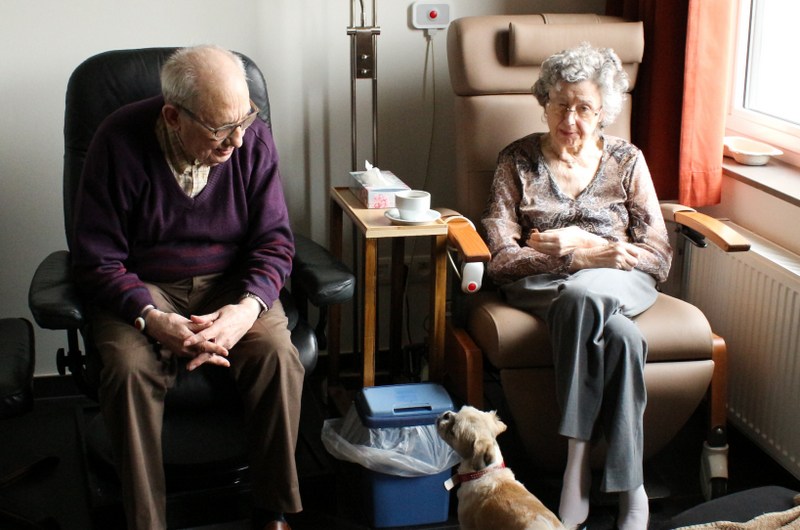More patients are using computers or smartphones to visit their doctors virtually, but not everyone can embrace telemedicine easily, especially elderly patients.
In West Virginia, where 20 percent of the population is older than 65, it's a particular problem, says Kimberly Wallace, a doctoral candidate at the West Virginia University School of Nursing and nurse practitioner with WVU Medicine.
“In specialty areas with older populations, telemedicine isn't always a possibility because our patient population is often not familiar with the technology,” she says.
A specialist in patients with chronic kidney disease, Wallace says people over age 65 are at an increased risk of developing it, and most of her patients fall into that age bracket.
Another reason her patients skew older? She practices in West Virginia, which includes the third-highest concentration of elderly residents per capita in the nation.
“I’ve encountered patients who don’t have a computer with a camera, an iPad or a smartphone, which lessens their ability to complete telemedicine visits,” Wallace said.
“I would say half my patients have chosen not to activate MyChart because they’re not comfortable with the internet.”
MyChart is a secure online system that allows patients to exchange direct messages with their healthcare providers and access their medical records in near real-time. It also has functionality for telemedicine and makes confidential video chats between healthcare providers and patients possible.
When tech support is family
COVID-19 only complicates matters. Before the pandemic, Wallace says some of her patients had been communicating with her well through MyChart, but stay-at-home orders have revealed that it wasn’t the patients themselves navigating MyChart.
With the patient’s permission, their children or grandchildren were doing it for them.
“COVID-19 has created a unique problem in that we’re incorporating telemedicine and video visits, but the patients sometimes don’t know how to use that technology, and the people who normally help them are being asked not to enter their home,” she said.
Because of these barriers, nurses and doctors may have to adapt telemedicine visits—which, crucially, include a video component most of the time—to telephone visits.
Laurie Theeke, a professor and director of the Ph.D. Program at the School of Nursing and nurse practitioner in the Department of Family Medicine, says nurses are also providing technical support when possible.
“In family medicine, we’ve had our nurses talking people through technical difficulties, but occasionally, I’ve had to do a phone visit because that patient couldn’t get connected,” Theeke said.
When a patient succeeds in accessing and navigating the telemedicine interface, patients can provide information by answering questions, she said.
“And if we are able to accomplish a video visit, we can also observe the patient to assess if they are distressed or having difficulty functioning, but there is limited ability to perform a physical examination,” Theeke said.
Some patients have been able to self-monitor blood pressures, blood sugars or daily weights at home. That’s helpful, but not every patient has access to this type of equipment.
Some information can’t even be conveyed over telemedicine. To name but one example, patients with chronic kidney disease—like the ones Wallace treats—need to provide blood samples on a routine basis for their kidney function to be assessed. That can’t happen from a distance.
A window into patients’ real lives
But telemedicine can help Wallace determine a patient’s current needs and whether he or she requires an in-person visit or lab work.
That can be a boon for patients who live hours from the WVU Medicine outpatient clinic in Fairmont, West Virginia, one of Wallace’s practice locations.
Who else benefits? Patients who can no longer operate a vehicle or those who rely on family members, friends, buses and medical transportation services for rides.
Theeke said another advantage of telemedicine is the window it gives nurses and doctors into patients’ everyday lives.
“It’s helpful with video visits to see the person in their own environment,” she said.
“As a provider, when you see someone in a sterile room, you’re not appreciating the real world they live in.
"With video visits, you might become aware of challenges they face that you wouldn’t be aware of if you saw them in clinic. This can give providers clues as to what other resources the patient may need.”
For instance, if a nurse sees that a patient’s numerous medications are disorganized, the nurse may check-in to make sure that the patient is taking them as prescribed. He or she can even recommend ways for the patient to organize them or set reminders to take them.
Putting research into practice
Given that a single factor of a patient’s life can have effects that ripple across his or her health and wellbeing, insights that seem trivial can be inordinately valuable to nurses and doctors.
A recent systematic review that Wallace co-authored—published in the Nephrology Nursing Journal—shows how these chain reactions can play out in the lives of hemodialysis patients.
She and her research partners—Saima Shafique, a doctoral student in epidemiology at WVU, and Ubolrat Piamjariyakul, the WVU School of Nursing’s associate dean for research—found that periodontal disease was associated with higher mortality rates in hemodialysis patients.
“Our systematic review supported that there’s a bidirectional relationship between periodontal disease and chronic kidney disease,” Wallace said.
“Individuals with advanced periodontal disease are more likely to have chronic kidney disease. Comparably, individuals with chronic kidney disease are more likely to have periodontal disease.”
This systematic review provided the foundation for Wallace’s upcoming dissertation study into oral health among West Virginia patients receiving hemodialysis, funded by the American Nephrology Nurses Association.
“The dual role of a student researcher and clinician can be challenging under normal circumstances, but it has become even more demanding during the recent COVID-19 pandemic,” Piamjariyakul said.
“As a mentor for Ph.D. candidates providing direct patient care, we recognize and support the balance between commitment to their patients and their doctoral program obligations.”
While meeting the demands of her dissertation work, Wallace continues to provide full-time care for nephrology patients during the COVID-19 pandemic.
“The patients I see are among the highest-risk population for severe illness because of COVID-19,” she said. “Right now, our primary goal for them is to keep them healthy and out of the hospital for other reasons.”
What she and her colleagues learn from the experience may apply to fields other than nephrology. Because older patients aren’t exclusive to kidney clinics, any nurse or doctor who has an older patient population is likely to face the same telemedicine challenges Wallace has.
“In my previous telemedicine research project with families of patients with chronic illness conditions, we faced the same challenges,” Piamjariyakul said. “But with a proper step-by-step algorithm with regular nurse telemedicine visits, participants became more familiar with technology.
"We had patients over 80 years old able to use computer and smartphone. One of my patients had to drive to the library parking lot to get an iPad connected to talk to the nurse. Telemedicine is the safe and viable option we have right now. Both patients and nurses have to adopt and adapt the technology.”
Wallace’s insights may also be relevant after the pandemic has ended.
“I personally don’t think we’ll ever go back to quote-unquote normal,” she said.
“I think that this is the direction healthcare was headed. It amazes me how quickly we, as healthcare providers, were able to make this transition. In different circumstances, it could have taken years to get to this level. Once the pandemic is behind us, I don’t see healthcare delivery going backward—and I think going back to only in-person interactions would be doing just that.”
Sign up to receive a FREE copy of West Virginia Explorer Magazine in your email weekly. Sign me up!


